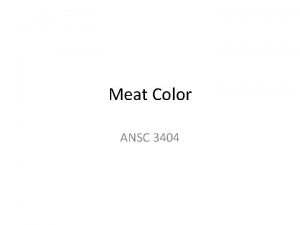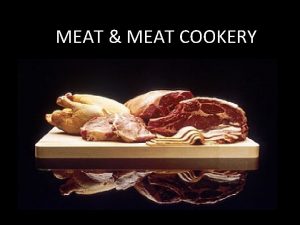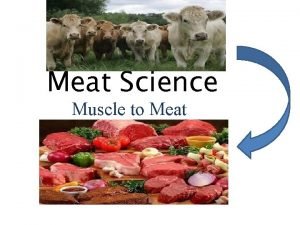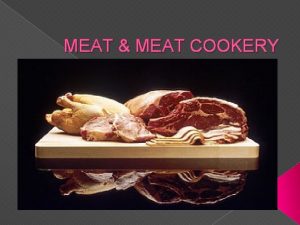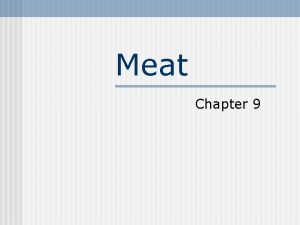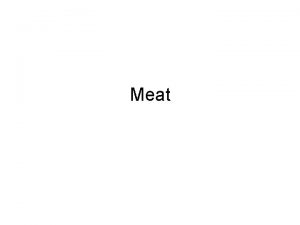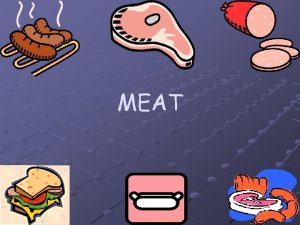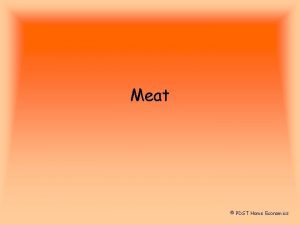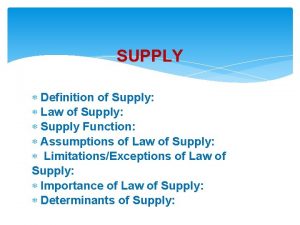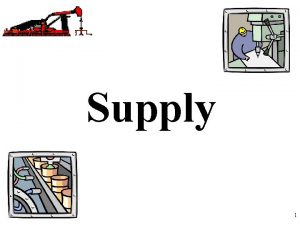Meat Unit 1 Where does our meat supply















- Slides: 15

Meat Unit

1. Where does our meat supply come from? A. Animal Name of Meat Steer Beef B. Young Steer (under 3 mo. ) Veal C. Hogs Pork D. Deer Venison E. Sheep Lamb F. Old Sheep Mutton

2. What nutrients are found in meat? A. Protein 1. Complete – contains all eight essential amino acids. 2. Helps to build, maintain and repair body tissue. B. Minerals 1. Iron – helps red blood cells carry oxygen to and away from the other body cells. 2. Zinc – needed by the body to form enzymes and insulin.

C. Vitamins 1. Riboflavin (B 2) – helps the body use energy and promotes healthy skin and good vision in bright light. 2. Niacin (B) – promotes healthy skin and nerves, aids digestion and fosters normal appetite. 3. B 12 – needed for normal functioning of body cells and of the nervous system.

Cuts of Meat A carcass is divided into portions called cuts. Primal cuts – large wholesale cuts. Subprimal cuts – small retail cuts.

*Refer to the Retail Cuts of Beef ditto to complete the following diagram: Draw lines on this carcass to show you would cut it into nine sections. Each section will spell out the name of one of the nine primal cuts. chuck rib brisket fore shank plate short loin sirloin flank round rib short loin sirloin brisket fore shank plate flank round

4. Each cut of meat contains: A. Lean – muscle tissue B. Connective tissue - gristle C. Fat cover – exterior fat D. Marbling – small flecks of fat throughout the lean E. Bone – can identify the part of the carcass it comes from

The amount of lean, connective tissue, fat and shape of bone influences the determination of the tenderness of the meat. On this basis, cuts are divided into tender and less tender. 5. Uniform Retail Meat Labeling A. The kind of meat - Beef B. The primal cut - Chuck C. The subprimal cut – Blade Roast

6. Meat Inspection and Grading A. All meat sold must, under law, pass inspection for wholesomeness. The purpose of inspection is to protect the consumer by guaranteeing that all meat sold is from healthy animals which were slaughtered and processed under sanitary conditions or is suitable for consumption. B. It is labeled with an inspection mark.

B. Quality refers to characteristics associated with the palatability of the lean (tenderness, juiciness and flavor). The quality of meat is identified by a grade shield. The top three grades are: Prime: The top or highest grade of meat containing the greatest degree of marbling. Choice: This grade contains sufficient marbling for taste and tenderness but is less costly than U. S. Prime and is the grade generally sold at retail stores. Good: Less marbling, not as tender lower in price but just as nutritious.

*Complete the following statements. Then find the answer in the jumble below and pencil in the shapes which contain the letters to each answer. Answers appear more than once. 1. The grade shield on beef indicates the quality of the product. 2. Wholesomeness in beef is indicated by the inspection mark. 3. The grade of beef sold in most stores is choice.

7. Meat Storage 1. Always plan to make beef the last purchase before returning home. 2. Fresh meat can be stored in the refrigerator from two to four days. 3. Freezing wrap must seal out air and lock in moisture. 4. Defrosting meat at room temperature not recommended.

8. Cooking Methods – refer to Cookery Methods ditto A. Tender cuts – Dry Heat Methods 1. Broiling 2. Roasting 3. Pan broiling – No added fat 4. Pan frying – Add fat and sauté B. Less tender cuts – Moist Heat Methods 1. Braising 2. Cooking in liquid

9. Tenderizing – used on less tender cuts of meat to cook them using a dry heat method. A. Marinade – Liquids which traditionally contain some sort of food acid such as vinegar, wine, citrus or tomato juice. The acid helps soften the meat fibers and connective tissue and adds flavor. Beef is placed in the marinade under refrigeration for 6 -24 hours. B. Pounding – With a heavy object such as a meat mallet. It tenderizes by breaking down the beef fibers, particularly the connective tissue.

C. Cubing – A more thorough process than pounding because it breaks down the fiber structure even more. Beef is “cubed” by machine. Do not confuse this with cutting the meat into cubes. D. Commercial Tenderizers – Come in various forms and contain active ingredients called enzymes. The enzymes break down the connective tissue.
 What is market forms of poultry
What is market forms of poultry Thinking affects our language, which then affects our:
Thinking affects our language, which then affects our: Our census our future
Our census our future Christ, be our light
Christ, be our light Marcus aurelius our life is what our thoughts make it
Marcus aurelius our life is what our thoughts make it We bow our hearts
We bow our hearts Our census our future
Our census our future Our life is what our thoughts make it
Our life is what our thoughts make it Money madness poem is written by
Money madness poem is written by Awareness of ourselves and our environment is:
Awareness of ourselves and our environment is: Awareness of ourselves and our environment is
Awareness of ourselves and our environment is God our father christ our brother
God our father christ our brother Our future is in our hands quotes
Our future is in our hands quotes Awareness of ourselves and our environment
Awareness of ourselves and our environment Is our awareness of ourselves and our environment.
Is our awareness of ourselves and our environment. Unit 10, unit 10 review tests, unit 10 general test
Unit 10, unit 10 review tests, unit 10 general test
















